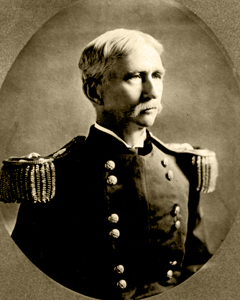Adelbert Rinaldo Buffington facts for kids
Quick facts for kids
Adelbert Rinaldo Buffington
|
|
|---|---|
 |
|
| Born | November 22, 1837 Wheeling, West Virginia |
| Died | July 10, 1922 (aged 84) Madison, New Jersey |
| Place of Burial | |
| Allegiance | Union |
| Service/ |
Union Army |
| Years of service | 1861–1901 |
| Rank | |
| Commands held | 10th Chief of Ordnance (1899–1901) |
| Battles/wars | American Civil War |
Adelbert Rinaldo Buffington (born November 22, 1837 – died July 10, 1922) was a high-ranking officer in the United States Army. He became a Brigadier General. He was also the 10th Chief of Ordnance for the U.S. Army Ordnance Corps. This means he was in charge of all the army's weapons, ammunition, and military equipment.
Contents
A Life of Service
Adelbert Rinaldo Buffington was born in Wheeling, West Virginia. This happened on November 22, 1837.
Becoming an Officer
In 1856, he joined the United States Military Academy at West Point. This is a famous school for training army officers. He worked hard and graduated in May 1861. He was one of the top students in his class.
Joining the Civil War
Right after graduating, Buffington was assigned to the Ordnance branch. This branch handles all military weapons and supplies. He immediately started training volunteer soldiers in Washington.
In June 1861, he was sent to the St. Louis Arsenal. This was a major place where weapons were made and stored. By April 1862, he was in command of this important facility. He even helped organize its defense during the American Civil War. At one point, he was made a Colonel of Volunteers and helped defend Pilot Knob, Missouri.
On October 25, 1862, he took command of the ordnance depot in his hometown, Wheeling, West Virginia. He also served as the Chief Ordnance Officer for the District of West Virginia. Later, in 1864, he commanded the New York Arsenal.
Post-War Innovations
After the Civil War ended, Buffington oversaw the closing down of Confederate weapons factories. These were in places like Baton Rouge and Galveston. From 1867, he worked at several important arsenals. These included Watertown, Watervliet, and Detroit Arsenals. He commanded the Detroit Arsenal from 1870 to 1872.
In 1872, he invented a special stand for large cannons. This stand could lower the cannon after it fired. This made it harder for enemies to see and hit. This invention was an early version of the "disappearing seacoast carriages." He later developed these with William Crozier. These special gun mounts became standard for coastal defenses in the United States for many years.
Leading at Springfield Armory
By June 1881, Buffington was a Lieutenant Colonel. He moved to command the Springfield Armory in September of that year. He stayed there for ten years. During this time, he created many new inventions.
- He helped design a new steel carriage for field guns. This included parts like the limber and caisson.
- He invented the "Buffington rear sight" for small arms. This was a special aiming device for rifles.
- He also developed a ramrod bayonet.
- He found a new way to make small gun parts dark blue to protect them.
- He created a special gas furnace for shaping small metal parts.
He also improved the workshops at Springfield Armory. He served on several important boards. These boards planned for new gun factories and repaired dams.
Becoming Chief of Ordnance
In February 1889, he was promoted to Colonel. In 1892, he became the commander of Rock Island Arsenal. During his five years there, he oversaw big construction projects. He rebuilt a bridge and a power dam system. In 1897, he took command of the Powder Depot at Picatinny Arsenal in New Jersey.
On April 5, 1899, he was promoted to Brigadier General. He then became the 10th Chief of Ordnance for the U.S. Army. In this top role, he managed a big change. The army started using a new, safer type of gunpowder called nitrocellulose. This meant many weapons had to be changed to handle the new powder.
Retirement
Adelbert Buffington retired on his 64th birthday. This was on November 22, 1901. He spent his retirement years at his home in Madison, New Jersey. He passed away there on July 10, 1922, at the age of 84.

